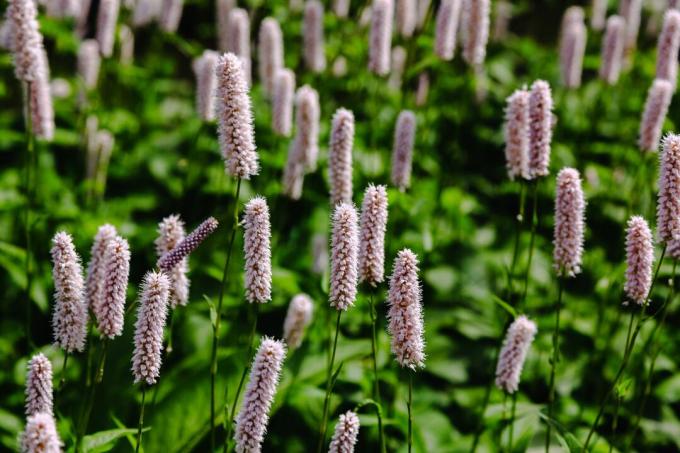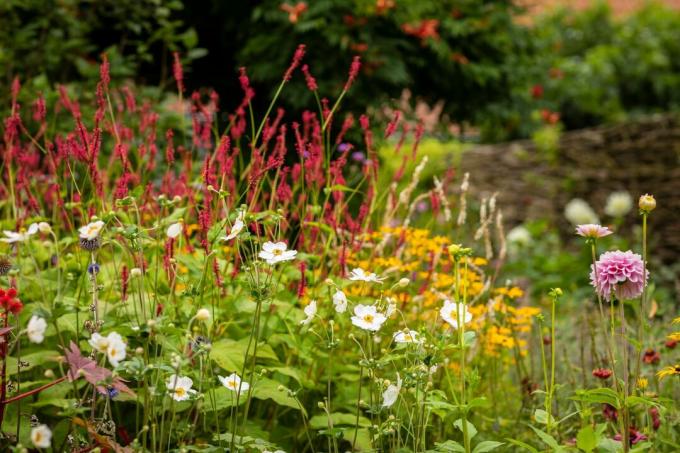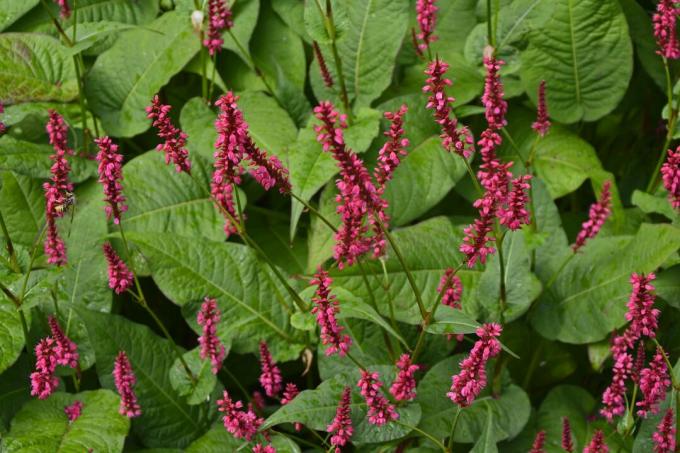The extremely decorative flowers and the large variety of varieties make the candle knotweed an increasingly popular perennial that is also quite undemanding.

The candle knotweed (Persicaria amplexicaulis) is a real asset in the garden, because it does not require any complex maintenance units and is generally very robust. In addition, it convinces with its long-lasting flowering and rapid growth. In combination with other plants, particularly attractive plantings can be created.
contents
- Candle knotweed: origin and characteristics
- The most beautiful types of knotweed for your garden
-
Plant candle knotweed
- Location and procedure
- Combine knotweed: good plant partners
- The right care: cutting, fertilizing and Co.
- Increase candle knotweed
- Is candle knotweed poisonous?
Candle knotweed: origin and characteristics
Persicaria amplexicaulis belongs to the knotweed family (Polygonaceae) and is also under the synonyms due to new taxonomic knowledge
Bistorta amplexicaulis and Polygonum amplexicaule known. The natural occurrence of the candle knotweed is in the Himalayan region and ranges from Afghanistan to China. There it grows preferentially in fresh to moist perennial corridors and on the edges of trees in sunny to shady locations.The deciduous perennial forms bushy clumps with a height of 100 to 120 cm. It gradually spreads through short runners. Between the densely growing, green foliage, the flower stalks soar up, at the tips of which are the candle-shaped flower panicles. Depending on the variety, they are colored white, pink, pink or red. The blooming splendor of the perennial can be admired for a surprisingly long time - from mid-July to the end of October. The leaves of the candle knotweed are about 5 to 15 cm long and grow around the stems, which is why a heart-like shape is formed. The perennial, robust plant is hardy and therefore does not need any special treatment in the cold season.

Is candle knotweed friendly to bees? The knotweed is a very good nectar and pollen plant and is therefore a food source for insects such as bees and butterflies. Depending on the variety, this property is more or less pronounced.
The most beautiful types of knotweed for your garden
The most noticeable distinguishing feature among the varieties of the candle knotweed is usually the flower color. All of the varieties presented here, with the exception of one that was classified as very good, were rated as excellent by the perennial sighting working group.
- Persicaria amplexicaulis ˈAlbaˈ: This bee-friendly variety impresses with its elegant, white flowers from August to October. It becomes 100 to 120 cm high and is also suitable as a cut flower.

- Persicaria amplexicaulis ˈAnnaˈ: The ˈAnnaˈ variety reaches a stately height of 120 to 140 cm and blooms in bright pink from July to October. Insects also enjoy it.
- Persicaria amplexicaulis ˈSaraˈ: This free-flowering variety impresses with excellent health and stability. It bears showy, purple-pink flowers from July to October and becomes 100 to 130 cm high. It is also suitable as an insect pasture.
- Persicaria amplexicaulis ˈTaurusˈ: The Taurusˈ candle knotweed, willing to flower, is slightly lower with its height of 80 to 100 cm. Its intense dark red flowers also adorn the perennial from July to October. With this variety, an ornamental red autumn color can also often be observed.

- Persicaria amplexicaulis ˈOrangofieldˈ: The unusual flower color makes this variety particularly interesting. Because with the salmon pink color it is a real eye-catcher. It reaches a height of 70 to 90 cm and is very willing to flower.
Tip: A related and also popular species is the meadow knotweed (Persicaria bistorta), also known as snake knotweed. It is well suited for sunny and humid locations such as the edges of waters. A popular variety is, for example, Superbaˈ.

Plant candle knotweed
The perennial grows optimally on the location mentioned below, but also thrives quite well in other places - at the expense of vitality. We will tell you more about the most suitable location and give you tips on planting.
Tip: The knotweed grows a bit overgrown with its rhizomes and can also grow through Increase self-sowing, but it is usually not a nuisance and is still good tame. One benefit of this growth is that weeds are effectively suppressed.
Location and procedure
Optimally will Persicaria amplexicaulis Planted in loosened, fresh to moist clay soils in a sunny to shady and sheltered location. A nutrient-rich, humus-rich and deep loam soil is best. The candle knotweed feels particularly at home on the edges of wood, but also on the banks of water, and fits perfectly in herbaceous borders and splendid herbaceous beds.
To improve the soil in a very sandy, barren soil, plenty of ripe compost or high-quality humus-rich soil can be mixed in. For example, ours is also suitable for this Plantura organic compostwhich provides the plant with a substrate with good water storage capacity and nutrient availability. A little sand or grit should only be worked into very compacted soils, because the knotweed can grow well even in dammed-up moisture.
A good time to plant the perennial is either in spring in mid-May or in autumn around September. If several specimens are combined in a group planting, a distance of about 50 cm should be maintained. Under no circumstances should more than three perennials be planted per square meter, because the individual plants will continue to spread over time.
Combine knotweed: good plant partners
A good combination of plants with the candle knotweed results, for example, from the harmonious flowering time of the Autumn anemone (Anemone hupehensis). But also asters (aster), phlox (phlox) and silver candles (Actaea simplex) are well suited as plant partners. With Ornamental grasses particularly interesting combinations can be created. On the other hand, you should generally avoid having smaller plant neighbors with the candle knotweed, as these would disappear within a short time due to lack of light and space.

The right care: cutting, fertilizing and Co.
As already mentioned, no time-consuming measures are necessary when caring for the candle knotweed. In order to give your perennial the best possible conditions for healthy growth, we explain some tips below.
pour
Freshly planted specimens of the knotweed should not be exposed to prolonged dry periods, so the soil around it is better kept well moist. Well-grown perennials can cope with occasional dry phases. Persistent waterlogging can damage the candle knotweed - especially if the soil is too wet in winter, there is a risk that the rhizomes of the plant will rot due to fungal attack.
Fertilize
The perennial does not depend on regular fertilizers on good soils, but benefits from it when compost or flower fertilizer granules like ours are ripe in spring Plantura organic flower fertilizer is incorporated into the substrate. As a result, important nutrients are added to the earth again and the life in the soil is supported.
To cut
The effects of strong winds or rainfall can be compensated for by cutting back halfway up and the plant will sprout again compactly within a short period of time. This measure can also induce renewed flowering in some cases.
Overwinter
For wintering, the withered leaves can simply be left on the ground, so the rhizomes are also protected from colder temperatures. In particularly wet and cool regions, the perennial can also be covered with brushwood.
Increase candle knotweed
Due to the self-sowing already mentioned, the candle knotweed multiplies reliably in autumn. In the following spring, several seedlings will be visible around the perennial, which can be easily removed or simply transplanted in the event of undesired propagation.
For propagation by hand, it is best to divide the perennial, which should be done about every three to four years anyway to rejuvenate the plant. For this purpose, the knotweed is dug up in spring shortly before it sprouts and the soil is shaken off a little from the roots. Now you separate off the parts of the plant that have already developed a good root system. All individual parts are now reinserted in the desired location and cast well.

Is candle knotweed poisonous?
Basically, the knotweed is not a plant intended for consumption. However, candle knotweed and other types of knotweed do not contain any toxins and therefore pose no danger to humans or animals. However, it should be noted that the plants can contain more or less high levels of oxalic acid, which can cause health problems at high concentrations. Especially children, pregnant women and people who are ill should not ingest any of the parts of the plant. Cats should not eat the plant either, as their bodies cannot break down the oxalic acid. However, damage only occurs when larger quantities are consumed.
Another interesting plant from the Polygonaceae family is the Blood vessel (Rumex sanguineus). Not only does it have decorative leaves, but it can also be added to salad, for example. You can find out more about this in our article.



